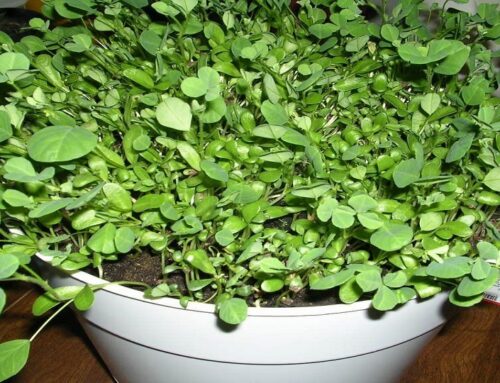Scientific name of seakale is Crambe maritime and it belongs to cabbage family or mustard family i.e. Brassicaceae (syn. Cruciferae). In other words, seakale is a Brassica vegetable or a cruciferous vegetable.
Sea kale is biennial in their growing habit but it is grown as an annual crop for vegetable purposes. Leaves of sea kale plants can be used as a nutritious leafy vegetable.
Regarding its origin, just like other Brassica vegetables, sea kale is also believed to be originated in the region comprising of Western Europe, the Mediterranean region and the temperate regions of Asia.
Food Uses and Nutrition of Sea Kale: Young leaves and shoots of seakale are used as a leafy vegetable. Raw leaves are not suitable for consumption. Some people use its roots also for cooking purposes.
Generally, blanched leaves of seakale are used for cooking as a vegetable. Freshly harvested, young and tender leaves are cleaned with running water, and then boiled without salt. After boiling, water is drained off. Now, these boiled and blanched leaves are ready for cooking. It can be cooked like other Brassica leafy greens.
Just like other Brassica vegetables, Seakale leaves are rich in dietary fiber, vitamins and minerals and low in fatty acids and cholesterol. It is rich in minerals like iodine, sulphur, Calcium, Potassium and Magnesium. Seakale leaves rich in Vitamin C, Vitamin A and Carotenoids (carotene is a precursor of Vitamin A).
Consumption of seakale leaves is helps in alleviating health disorders such as osteoporosis, heart ailments, and dementia.
Growing Sea Kale: Seakale is a hardy plant, and it is very easy to grow these plants. In some parts of the world, it is considered as an invasive species and therefore is grouped among the weeds. However, because of its high nutritional value, these plants are now a favourite among diet-conscious people and are slowly gaining popularity among the home gardeners worldwide.
Growing practices for sea kale plants are almost similar to that of cabbage plants. In appearance also, these plants look similar to cabbage plants, particularly, leaves of sea kale plants. Leaves of sea kale are serrated and are bluish-green in colour.
Sea kale plants prefer sunlight but it can be grown in partial shade also. Well-drained, sandy loam soils that are rich in organic matter and highly fertile are suitable for its growth. These plants prefer slightly alkaline soils that are rich in salts. Sea kale plants thrive well in areas where a slightly damp and moist climate is prevalent. You can find them growing abundantly in places near sea shores.
Propagation of sea kale plants is by seeds. Seeds may be directly sown in the gardens. Seedlings should emerge within 14-21 days, if soil temperature is favourable. In case of overcrowding, thinning of seedlings may be practiced.
Best time for raising a sea kale crop in tropics and subtropics is from March to June. For a commercial crop or for large-scale planting, seeds may be sown in a well-prepared nursery beds. Then seedlings are transplanted in the main fields when attain a height of 10-15cm.
Soon after transplanting, irrigation/watering is done. After that, need-based watering is done.
Regarding plant nutrition, FYM of compost@15-20tons/acre may be incorporated into the top soil of gardens/fields before a few weeks of transplanting seedlings. This will enhance the soil fertility. After that, liberal applications of nitrogenous fertilisers are recommended to promote leaf production. Fertilisers are applied during active vegetative growth phase. For a small crop in kitchen gardens, foliar application of urea or liquid nitrogen is advised at monthly intervals.
There are no major diseases and pests. However, snails and slugs may be a problem sometimes. So are thrips, aphids and white flies. They can be effective controlled by pyrethrum-based pesticidal formulations.
Check out our publishing services here…
We publish top quality videos on various ‘Food & Agriculture’ topics. You may subscribe our video channel here…






